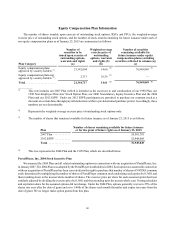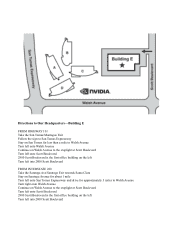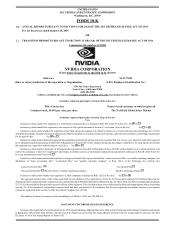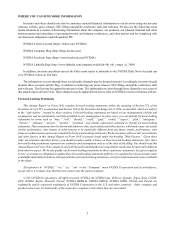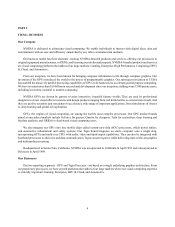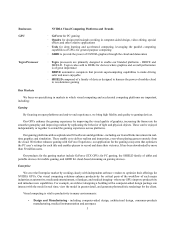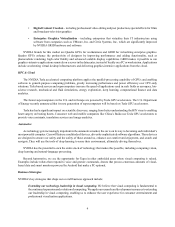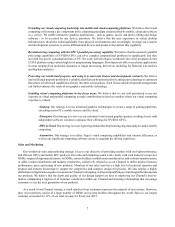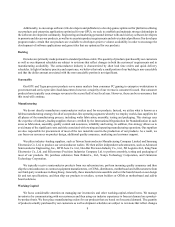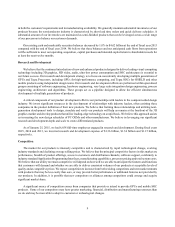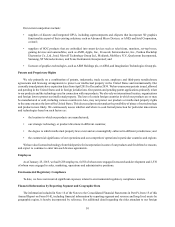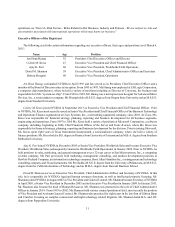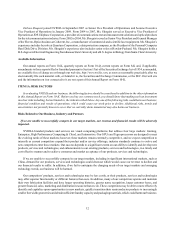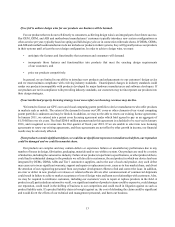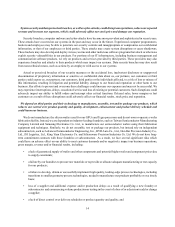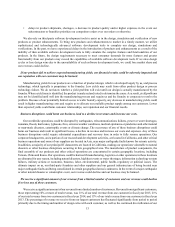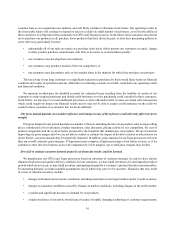NVIDIA 2015 Annual Report Download - page 86
Download and view the complete annual report
Please find page 86 of the 2015 NVIDIA annual report below. You can navigate through the pages in the report by either clicking on the pages listed below, or by using the keyword search tool below to find specific information within the annual report.6
• Digital Content Creation - including professional video editing and post production, special effects for films
and broadcast-television graphics
• Enterprise Graphics Virtualization - including enterprises that virtualize their IT infrastructure using
software from companies such as VMware, Inc. and Citrix Systems, Inc., which are significantly improved
by NVIDIA GRID hardware and software
NVIDIA brands for this market are Quadro GPUs for workstations and GRID for virtualizing enterprise graphics.
Quadro GPUs enhance the productivity of designers by improving performance and adding functionality, such as
photorealistic rendering, high color fidelity and advanced scalable display capabilities. GRID makes it possible to run
graphics-intensive applications remotely on a server in the datacenter, instead of locally on a PC or workstation. Applications
include accelerating virtual desktop infrastructures and delivering graphics-intensive applications from the cloud.
HPC & Cloud
The NVIDIA Tesla accelerated computing platform applies the parallel-processing capability of GPUs and enabling
software to general-purpose computing problems, greatly increasing performance and power efficiency over CPU-only
solutions. Tesla-based servers and supercomputers increase the speed of applications used in such fields as aerospace, bio-
science research, mechanical and fluid simulations, energy exploration, deep learning, computational finance and data
analytics.
The fastest supercomputers in the U.S. and in Europe are powered by Tesla GPU accelerators. The U.S. Department
of Energy recently announced that its next generation of supercomputers will be based on Tesla GPU accelerators.
Tesla has had a significant impact on scientific discovery, ranging from better understanding the HIV virus to enabling
heart surgery on beating hearts. Consumer web and mobile companies like China’s Baidu use Tesla GPU accelerators to
provide voice assistants, translation services and image analytics.
Automotive
As technology gets increasingly important in the automotive market, the car is on its way to becoming each individual’s
most powerful computer. Cars will feature a multitude of devices, driven by sophisticated software algorithms. These devices
are designed to ensure our safety and the safety of those around us, enhance our comfort and enjoyment, and search and
navigate. They will use the tools of deep learning to sense their environment, ultimately driving themselves.
NVIDIA has the potential to own the entire stack of technology that makes this possible, including computing vision,
deep learning and natural-language processing.
Beyond Automotive, we see the opportunity for Tegra in other embedded areas where visual computing is valued.
Examples include robots that respond to voice and gesture commands, drones that process enormous amounts of visual-
based data and smart monitors powered by Android that make a PC optional.
Business Strategies
NVIDIA’s key strategies that shape our overall business approach include:
Extending our technology leadership in visual computing. We believe that visual computing is fundamental to
the continued expansion and evolution of computing. We apply our research and development resources to extending
our leadership in visual computing, enabling us to enhance the user experience for consumer entertainment and
professional visualization applications.



